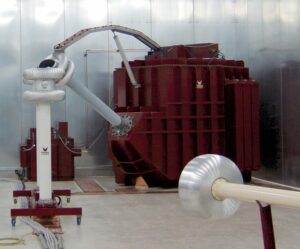TRATOS® HV – 76 kV to 132 kV – (145 kV) – CU/XLPE/AT/HDPE
Energy Cables / High Voltage Cables - HV Energy Cables / DNO Approved Cables / HV Energy Cables DNO

Tratos is an international manufacturer and supplier of High Voltage Cables (HV cables) and (EHV) Extra High Voltage Cables up to 245 kV. Established in 1966, it has been involved in this emerging market segment, starting production of HV Cables up to 245 kV in 2009.
Tratos supplies High Voltage cables to international markets. Its HV cables benefit from advanced technology and construction, producing cable that is flexible, light and strong.
Tratos High Voltage cables are distinguished by Tratos’ ongoing investment in the latest technology, materials and human resources needed to meet the highest safety and performance requirements demanded of HV and EHV cables installed in Electrical Transmission Systems around the world.

Read more about Independent Testing of Tratos’ High-Voltage Cables by KEMA Labs
The fact that this cable successfully withstood 10 successive 750 kV positive and then negative impulses only confirms the integrity of the cable.
It is reassuring to note that the results obtained by KEMA align closely with the results of the in-house test carried out by Tratos.
The quality of the insulation used and the competence of Tratos to produce 150 kV and higher voltage power cables give assurance to any potential customer of a long trouble free life when using this cable.
A reliable, successful Transmission system needs more than simply a high-quality cable. In collaboration with suppliers of compatible, new-generation joints and terminations, Tratos is able to supply turnkey projects involving design, production, installation and maintenance. Be it AC or DC power transmission on land or subsea, Tratos is able to supply any HV cable with accessories up to 245 kV.
 Tratos not only supplies insulated Power Transmission high voltage cables but also manufactures a complementary range of High-Temperature Low Sag (HTLS) overhead conductors made from an innovative hybrid lightweight carbon fibre/glass/aluminium sheathed central strength member with high-temperature zirconium-aluminium wires (TAL) as the conducting element.
Tratos not only supplies insulated Power Transmission high voltage cables but also manufactures a complementary range of High-Temperature Low Sag (HTLS) overhead conductors made from an innovative hybrid lightweight carbon fibre/glass/aluminium sheathed central strength member with high-temperature zirconium-aluminium wires (TAL) as the conducting element.
Tratos constructed the largest Faraday cage test site in Europe at its headquarters in Pieve Santo Stefano, Italy. Measuring 24m x 16m and standing at 14m high, the new cage enables Tratos to carry out AC resonant tests on site of up to 245kV of nominal voltage cables and up to 20 km in length.
Read more about Tratos Faraday cage
Energy Cables / High Voltage Cables - HV Energy Cables / DNO Approved Cables / HV Energy Cables DNO
Energy Cables / High Voltage Cables - HV Energy Cables / DNO Approved Cables / HV Energy Cables DNO
Energy Cables / High Voltage Cables - HV Energy Cables / DNO Approved Cables / HV Energy Cables DNO
Energy Cables / High Voltage Cables - HV Energy Cables / DNO Approved Cables / HV Energy Cables DNO
Energy Cables / High Voltage Cables - HV Energy Cables / DNO Approved Cables / HV Energy Cables DNO



Please, don’t hesitate to contact us for additional information on our company or our products.
 Tratos constructed the largest Faraday cage test site in Europe at its headquarters in Pieve Santo Stefano, Italy. Measuring 24m x 16m and standing at 14m high, the new cage enables Tratos to carry out AC resonant tests on site of up to 245kV of nominal voltage cables and up to 20 km in length. AC resonant testing is now the standard method of testing higher voltage cables. However, it is vital that AC resonant tests are carried out in a controlled environment, which is exactly what the Faraday cage provides.
Tratos constructed the largest Faraday cage test site in Europe at its headquarters in Pieve Santo Stefano, Italy. Measuring 24m x 16m and standing at 14m high, the new cage enables Tratos to carry out AC resonant tests on site of up to 245kV of nominal voltage cables and up to 20 km in length. AC resonant testing is now the standard method of testing higher voltage cables. However, it is vital that AC resonant tests are carried out in a controlled environment, which is exactly what the Faraday cage provides.
The facility incorporates a new innovative locking system to ensure perfect shielding from any external interference. Inside is state-of-the-art instrumentation and equipment for testing and an adjustable high-voltage reactor, which, together with the exciter and the regulator, comprise the heart of the system. The reactor is insulated in oil and comprises of two identically wound High-Voltage coils mounted on a platform, with a motorised drive mechanism providing variable air gaps. Its upper part includes space for oil expansion, and it offers 12MW of resonance power, allowing three taps of 350kV, 150kV and 70kV.
Mounted in a separate oil-filled steel tank, the exciter section contains a single-phase, a step-up transformer which supplies the AC voltage for the resonant circuit. The regulator provides an adjustable input voltage to the exciter and controls the input voltage of the reactor. This sophisticated equipment can detect even very low levels of electrical discharge, down to pico coulomb level. It is governed by a modern control system incorporating a Programmable Logic Controller (PLC), which is designed for multiple inputs and output arrangements, immunity to electrical noise, and resistance to vibration and impact. This allows incredibly precise measurements to be recorded, ensuring cables meet exacting IEC 60840 test parameters.

What makes this cable particularly important is the fact that Tratos supplied it to the International Thermonuclear Experimental Reactor’s (ITER) Fusion4Energy project.
The cable tested by KEMA Labs was a 1×400 mm2 Aluminium conductor, XLPE Insulated, Polyethylene sheathed cable rated 87/150 kV manufactured by Tratos CAVI S.p.A. (Tratos Cable Type ARE4H1H5M1).
The design of the cable and the testing were in accordance with IEC 60840: Power cables with extruded insulation and their accessories for rated voltages above 30 kV (Um = 36 kV) up to 150 kV (Um = 170 kV) – Test methods and requirements.
Testing was carried out in April 2020. in the KEMA Labs facility in Arnhem, the Netherlands.
Total overall control of the design, manufacture and quality procedures ensures cables produced by Tratos have the pliability, strength, reduced weight and, above all, reliability demanded by installers in this crucial market segment.
Like most major International cable makers, Tratos purchase the XLPE that they use to manufacture their range of HV cables from a world renowned supplier of these types of materials. However, purchasing high-performance, high-quality XLPE does not of itself guarantee a top-quality cable; knowledge and experience are also required. The fact that in two separate tests, the equipment KEMA was using could not detect any discharge within the insulation of the Tratos cable under test, meaning no ionisation, at 1.5Uo should give reassurance to any prospective customer of the capability of the equipment, technology and human resource employed by Tratos. Not only is the XLPE insulation of this cable void free, but also the interfaces with the semi-conductive conductor screen and core screen.
Similarly, the very low level of Tan δ, measured by KEMA at 25 times less than the maximum allowable figure, will result in less dielectric heating losses throughout the operational life of this cable. Tan δ, the Dielectric Power Factor (also called the Dielectric Loss Angle (DLA)), although inherently linked to the composition of the XLPE material, can be adversely affected if not handled and processed correctly, leading to greater dielectric losses. As all cable engineers know, the lower the Dielectric Loss Angle, the lower the dielectric heating losses.
It should be noted that International technical specifications (CENELEC and IEC) refer to values of Um rather than country-specific rated voltages for HV cables and higher voltages:
Extra High Voltage (EHV) cables are generally taken to include:
Our website uses cookies and thereby collects information about your visit to improve our website (by analyzing), show you Social Media content and relevant advertisements. Please see our cookies page for further details or agree by clicking the 'Accept' button.
Below you can choose which kind of cookies you allow on this website. Click on the "Save cookie settings" button to apply your choice.

This content is blocked. Accept cookies within the '%CC%' category to view this content.